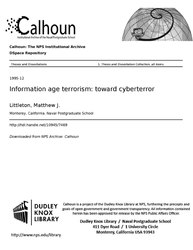File:Information age terrorism- toward cyberterror (IA informationgeter109457469).pdf

Original file (1,275 × 1,650 pixels, file size: 35.87 MB, MIME type: application/pdf, 153 pages)
Captions
Captions
Summary[edit]
| Information age terrorism: toward cyberterror
( |
||
|---|---|---|
| Author |
Littleton, Matthew J. |
|
| Title |
Information age terrorism: toward cyberterror |
|
| Publisher |
Monterey, California. Naval Postgraduate School |
|
| Description |
The growing ubiquity of computers and their associated networks is propelling the world into the information age. Computers may revolutionize terrorism in the same manner that they have revolutionized everyday life. Terrorism in the information ageB will consist of conventional terrorism, in which classic weapons (explosives, guns, etc.) will be used to destroy property and kill victims in the physical world; technoterrorism, in which classic weapons will be used to destroy infrastructure targets and cause a disruption in cyberspace; and cyberterrorism, where new weapons (malicious software, electromagnetic and micowave weapons) will operate to destroy data in cyberspace to cause a disruption in the physical world. The advent of cyberterrorism may force a shift in the definition of terrorism to include both disruption and violence in cyberspace in the same manner as physical destruction and violence. Through the use of new technology, terrorist groups may have fewer members, yet still have a global reach. The increasing power of computers may lower the threshold of state sponsorship to a point where poor states can become sponsors and rich states are no longer necessary for terrorist groups to carry out complex attacks. This thesis explores the shift toward information warfare across the conflict spectrum and its implications for terrorism. By examining the similarities and differences with past conventional terrorism, policymakers will be able to place information age terrorism into a known framework and begin to address the problem. Subjects: |
|
| Language | English | |
| Publication date |
December 1995 publication_date QS:P577,+1995-12-00T00:00:00Z/10 |
|
| Current location |
IA Collections: navalpostgraduateschoollibrary; fedlink |
|
| Accession number |
informationgeter109457469 |
|
| Source | ||
| Permission (Reusing this file) |
This publication is a work of the U.S. Government as defined in Title 17, United States Code, Section 101. As such, it is in the public domain, and under the provisions of Title 17, United States Code, Section 105, may not be copyrighted. | |
Licensing[edit]
| Public domainPublic domainfalsefalse |
This work is in the public domain in the United States because it is a work prepared by an officer or employee of the United States Government as part of that person’s official duties under the terms of Title 17, Chapter 1, Section 105 of the US Code.
Note: This only applies to original works of the Federal Government and not to the work of any individual U.S. state, territory, commonwealth, county, municipality, or any other subdivision. This template also does not apply to postage stamp designs published by the United States Postal Service since 1978. (See § 313.6(C)(1) of Compendium of U.S. Copyright Office Practices). It also does not apply to certain US coins; see The US Mint Terms of Use.
|
 | |
| This file has been identified as being free of known restrictions under copyright law, including all related and neighboring rights. | ||
https://creativecommons.org/publicdomain/mark/1.0/PDMCreative Commons Public Domain Mark 1.0falsefalse
File history
Click on a date/time to view the file as it appeared at that time.
| Date/Time | Thumbnail | Dimensions | User | Comment | |
|---|---|---|---|---|---|
| current | 01:51, 22 July 2020 |  | 1,275 × 1,650, 153 pages (35.87 MB) | Fæ (talk | contribs) | FEDLINK - United States Federal Collection informationgeter109457469 (User talk:Fæ/IA books#Fork8) (batch 1993-2020 #18768) |
You cannot overwrite this file.
File usage on Commons
The following page uses this file:
Metadata
This file contains additional information such as Exif metadata which may have been added by the digital camera, scanner, or software program used to create or digitize it. If the file has been modified from its original state, some details such as the timestamp may not fully reflect those of the original file. The timestamp is only as accurate as the clock in the camera, and it may be completely wrong.
| Short title | Information age terrorism: toward cyberterror |
|---|---|
| Author | Littleton, Matthew J. |
| Software used | Littleton, Matthew J. |
| Conversion program | Adobe Acrobat 9.51 Paper Capture Plug-in |
| Encrypted | no |
| Page size |
|
| Version of PDF format | 1.4 |

